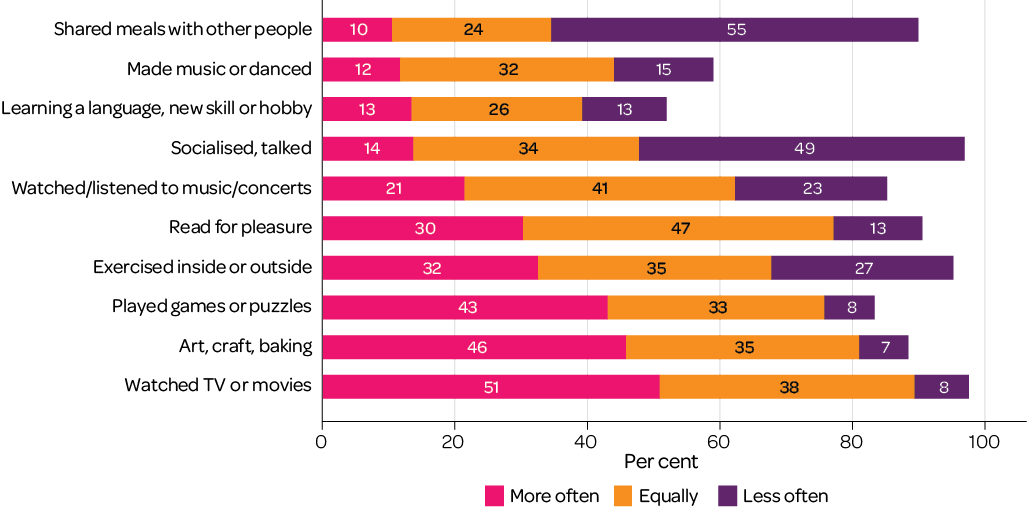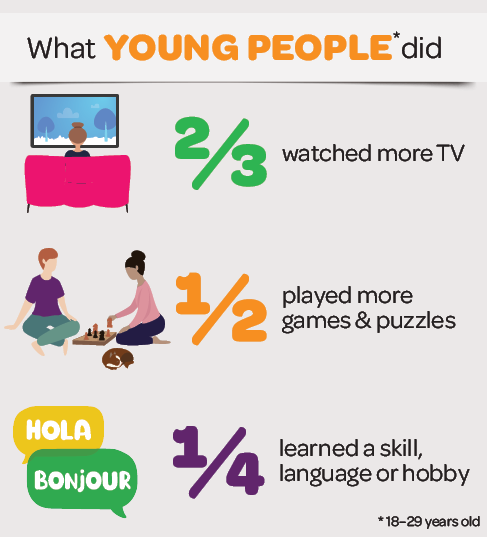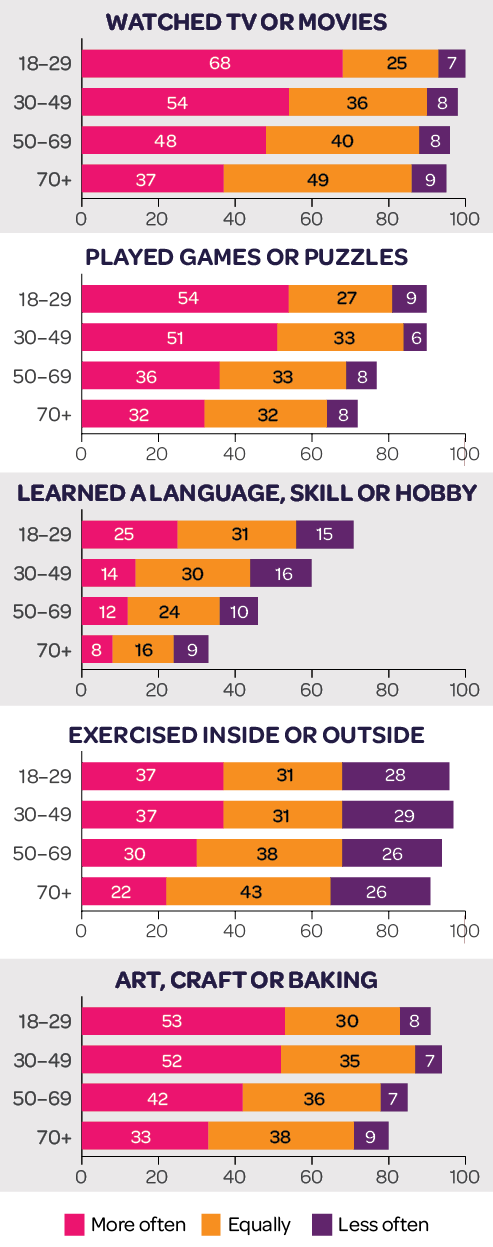Life during COVID-19: What we did during lockdown
Families in Australia Survey report
September 2020
Jennifer Baxter, Mikayla Budinski, Megan Carroll, Kelly Hand
Download Research report
Overview
Each family has had their own unique experience of the COVID-19 restrictions and lockdown. One area particularly affected by the restrictions was our leisure time, outside of school, work and other responsibilities. Stay-at-home directives and the loss of usual forms of recreation meant many of our usual activities were closed, and many of us had to find new ways to spend our spare time.
In this report, we look at how COVID-19 affected our recreational and 'spare time' activities. We explore how we spent time with our family as well as how we spent time alone and with others.
The survey was conducted from May to early June 2020. Depending on when people did the survey in this period and where they live, some responses are from those who were less restricted in their activity options.
Key messages
-
The most popular activity we spent more time doing was watching TV and movies (51%). This was particularly true of young adults under 30 (68%).
-
The second activity we were most likely to spend more time on was baking or doing art and craft (46%). This was especially true for both women and people with children.
-
Those who were working from home were most likely to increase time on shared meals and exercise. Stopping work during this time was associated with increased time learning a new language, hobby or skill and arts, craft and baking.
-
People living alone were the most likely to do social activities virtually and in real life.
-
Exercise was important for many, done alone by 57% of those doing some exercise and done with others in the household by 52% of those exercising.
Activities we did less of
Restrictions on activities outside the home had an impact on leisure activities, and especially opportunities to socialise and talk with others and share meals with others. Many did these activities less and few did them more often during COVID-19.
Some spent less time exercising, and people spoke of missing sport in particular. Others reported impacts on the time they spent watching or listening to music or concerts.
I miss going to group classes at gym. Work has gotten a lot more busy and I have gone from 5 group classes a week to not exercising at all. ... I miss church ... I miss salsa dancing. I miss seeing my partner who's overseas and going hiking with him.
Female, 32, from NSW with partner currently living elsewhere
Activities we did more of
With families spending more time at home, and outside of the home activities restricted, people found themselves with more time to do more of their usual leisure activities, as well as time to try some new ones. This is what people told us they were doing more of:
- Half our respondents reported that they were spending more time watching TV and movies.
- Just under half were spending more time baking, doing art and craft (46%) or playing games and doing puzzles (43%).
- One in three found they were exercising more, either inside or outside.
- Thirty per cent spent more time reading for pleasure.
We often eat meals together during the week but during the lock in we have had some really special family dinners where we have cooked special food and spent the evening playing board games and card games, and sharing lots of banter and laughter.
Female, 56, lives with partner and two young adult children in Victoria
Figure 1: Time spent on activities during COVID-19 compared to pre-COVID-19

Note: The bars add to the percentage who said this activity was applicable to them.
Who did what
Increased time spent on particular activities varied but there were trends according to the gender, age, household composition and work status of respondents.1
- Women, rather than men, were especially likely to be spending more time on art, craft and baking, on games and puzzles and reading for pleasure.
- People with children were the most likely to be spending more time on games and puzzles, on making music and dance, exercising, and art and craft and baking.
- Young people aged 18-29 years were the most likely age group to be spending more time watching television and movies. They were also the most likely to be spending more time learning a new language, skill or hobby and playing games or puzzles.
- Those under 50 years old were more likely than those over 50 to report increases in shared meals, playing games and puzzles, and in making music or dancing.

Figure 2: Time spent on individual activities during COVID-19 compared to pre-COVID-19 by age

1 This analysis is based on a logistic regression model comparing the characteristics of respondents who reported doing more of each activity, with the characteristics of those who did not (i.e. no change, decrease, or not applicable). The characteristics included in the model were gender, age, work status, whether working from home, household composition and region of residence.
Those with more time at home
People's work arrangements during COVID-19 also mattered in explaining how leisure time changed for different people.
- Those who stopped working during COVID-19 were more likely than those who did not to spend an increased amount of time on all activities. This was especially the case for learning a new language, hobby or skill and on art, craft and baking.
- Across all activities, those who were working at home during COVID-19 were more likely than those working away from home to report increases, particularly in having shared meals with others and exercising.
Having both parents work from home has meant that we can more easily have dinner as a family - instead of someone being stuck at work late or rushing to pull something together we are able to eat nice meals together at the table as we're already at home!
Female, 37, lives with partner and two young children in ACT
Some people told us that pressures of work and study meant they did not have more leisure time during COVID-19.
It should be noted: there is not extra time to do hobbies or learn something new when you are still working and studying full-time. Both adults have busy full-time jobs and child is in Year 12 doing HSC, so there is not a lot of spare time that people seem to be talking and joking about on social media. The things we do more of together are walking the dog and talking a lot about everything, small and big, which has been wonderful.
Female, 48, lives with partner and teenage child in NSW
Who we did activities with, and how
Given that many people were restricting their activities outside the household it was not surprising that, when asked, most people said that whatever activity they did, it was largely done alone or with others in their household. Where others were involved it tended to be activities that were done virtually rather than IRL (in real life). Sometimes these virtual activities were new to people and sometimes they were simply a new way of doing a previous activity.
My dance classes have all moved online, and moving all my other workouts online has been a struggle with having so much screen time. I probably would have stopped without my housemate who decided to do all the workouts with me.
Female, 21, lives alone in Queensland
My daughter and I have enjoyed watching the concerts that were live streamed by the Australian Ballet.
Female, 47, lives with partner and teenage daughter in ACT
How we socialised
As noted earlier, many people spent less time socialising and sharing meals with others during COVID-19.
Where people were socialising or spending time with others, this was often through virtual means during COVID-19. Those living alone were the most likely to socialise or talk with others through virtual means (among those who spent time socialising, 72% vs 59% of those not living alone). They were also the most likely to be socialising or talking in real life (51% vs 31% of those not living alone).
Additionally, people living alone were more likely than others to be catching up with others outside the household for meals (74% of those living alone sometimes sharing meals reported doing so with others in real life and 34% doing so virtually).
We have been cooking with my two sisters and their kids over Skype weekly, where we all cook the same thing together,
Female, 41, lives with two young children in NSW
Visited and shared meals kids and grandkids, in person where possible, and online.
Male, 69, lives with partner in NSW
Finding ways to exercise
Many people found ways to maintain or increase exercise time in a variety of forms including walking, bike riding and running.
Sometimes exercise was done alone (57%) and sometimes it provided an opportunity for family time (52% sometimes exercised with those they live with).
Our family has started each day with a long walk or scooter/bike riding, which has been fantastic for our health (physical/mental), to connect with others (simply saying 'hello' to passersby on the street) and to support our local business by buying and enjoying a coffee or juice.
Female, 36, lives with partner and three young children in NSW
For a smaller proportion (17%), exercise was done with others outside the household, providing a chance to socialise. Those living alone were more likely than those living with others to exercise with people outside their household (27% compared to 15%).
Figure 3: Who, with or how activities were done

What activities were important to us?
We asked people to tell us about the activities that were important to them. The wide range of responses given shows the diverse experiences of families during this time.
Spent more time talking and doing both housework and gardening with my partner ... being isolated from others freely during the lockdown didn't increase any level of stress but in fact allowed a more relaxed atmosphere.
Male, 72, lives with partner in NSW
Teaching the children some cooking skills has been something they have enjoyed. Playing games together likes snap, Fish, Uno and Jenga has been really enjoyable. Folding out the futon bed and watching family movies and having garlic bread has become a nice family memory for the three of us.
Male, 43, Tasmania
My kids have taken this time to learn to improve their cooking skills. They try a new recipe each night for dinner. It has been brilliant!
Female, 43, lives with partner and two teenage children in NSW
Cleaning and cooking shared by all members of the household.
Male, 28, shares house with other adults in Queensland
Spent a lot more time outdoors as a family riding bikes, walking and playing in the park. More time with my partner at home. We have a technology free night where we play games or talk. And a date night in with candles and a home-cooked meal.
Female, 38 lives with partner and young child in Victoria
Each week we have played games online with family that live in another suburb, town and country. We have been more connected all together at the same time. Normally we would all catch up individually over the week. Now we do the individual calls and the group calls each week.
Female, 54, lives with partner in Queensland
Adopted a dog. Gardening and planting fruit trees. Visiting grandparents every Sunday for lunch. Restarted weekly yoga classes (virtually).
Female, 44, single parent with young teenager in Tasmania
About the survey
Life during COVID-19 was the first survey in the Families in Australia Survey (AIFS' flagship survey series). The first wave ran from May 1 to June 9 2020, when all states were in various stages of lockdown. There were 7,306 respondents. A second survey wave is planned for November 2020.
Contact
For more information, visit the Families in Australia Survey project page or email [email protected].
Credits
Editor: Katharine Day
Graphic design: Lisa Carroll
Featured image: © GettyImages/Daniel Besic
Baxter, J., Budinski, M., Carroll, M., & Hand, K. (2020). Life during COVID-19: What we did during lockdown. (Families in Australia Survey report). Melbourne: Australian Institute of Family Studies.